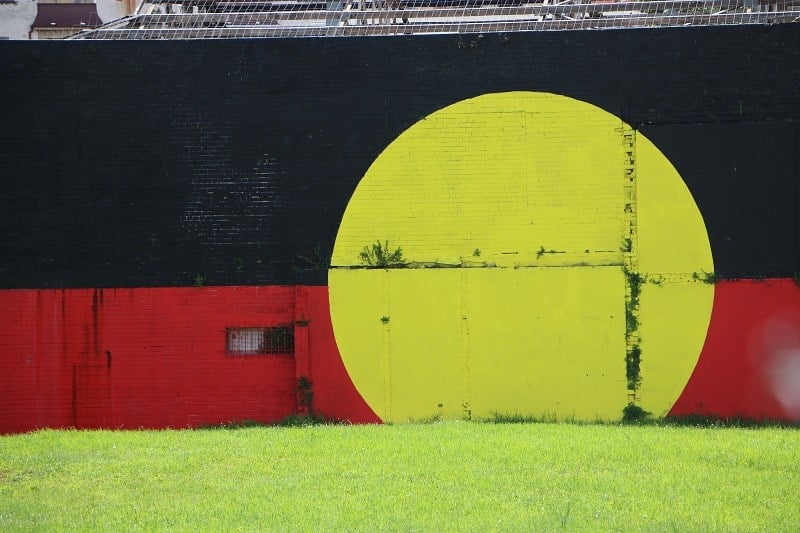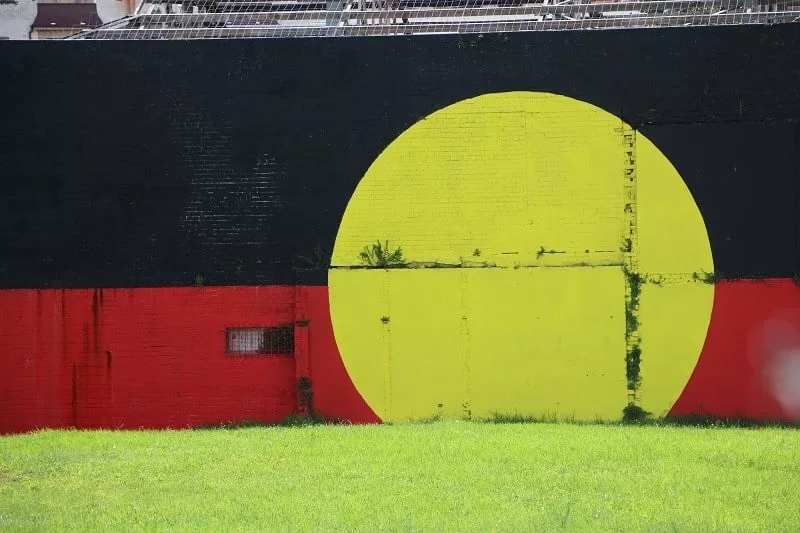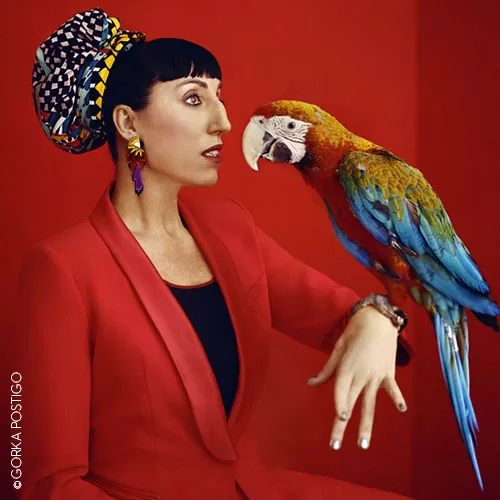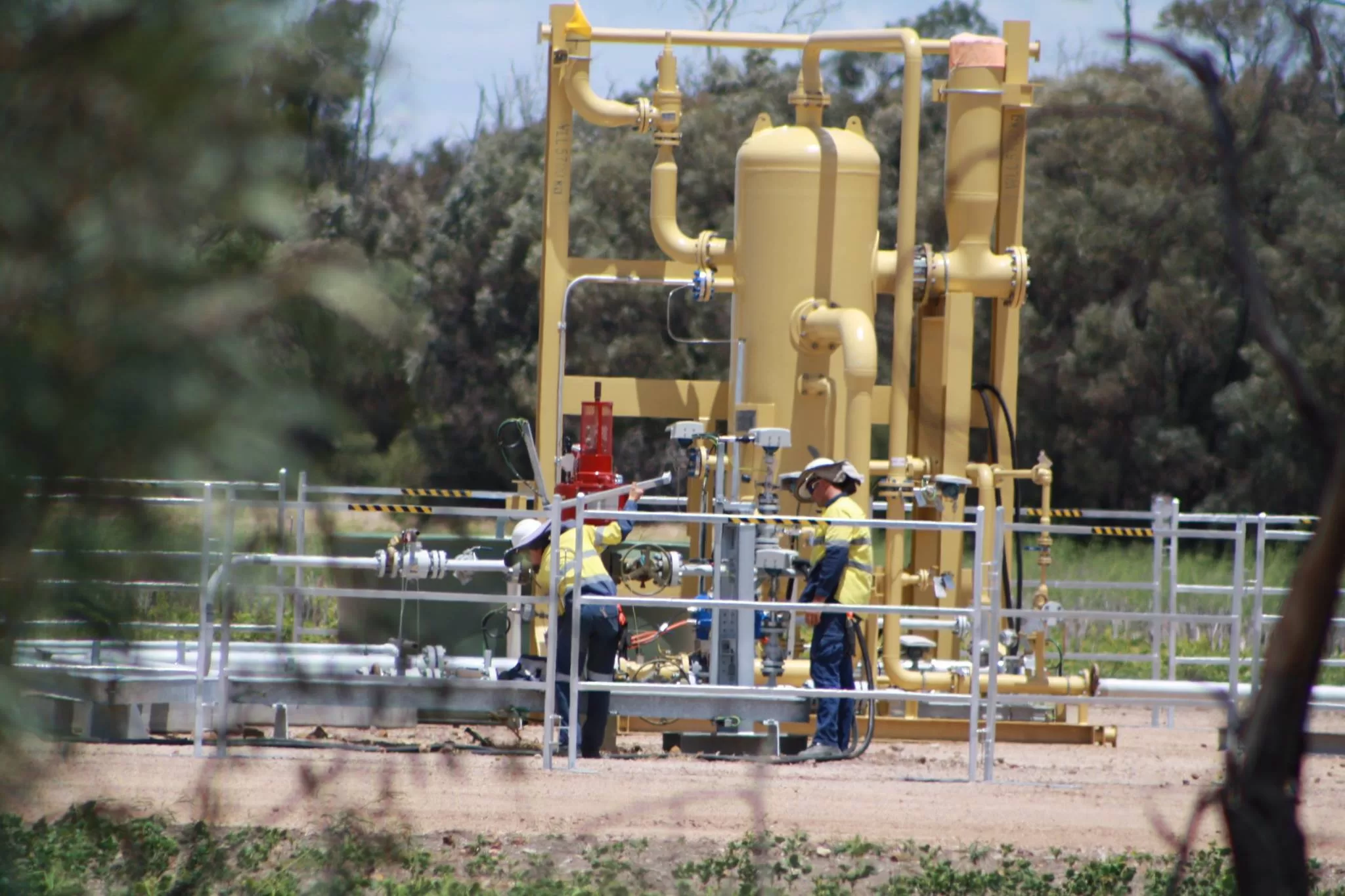A famous Aboriginal flag mural overlooked the ‘The Block’, Redfern, an enclave of Indigenous people in Redfern, inner-city Sydney.
The Block was the scene of the 2004 Redfern riots, which followed the death of 17-year-old First Nations youth Thomas Hickey, killed after being impaled on a fence while being followed by police.
More than 50 police were injured on 15 February 2004 with eight police officers treated in hospital. Bottles, bricks, live fireworks and Molotov cocktails were thrown during the riot until police used fire brigade water hoses to disperse the crowd. The Redfern railway station and a police car was set on fire during the riot which sent smoke billowing through the streets.
The famous mural of the Aboriginal flag at The Block
The flag mural was painted in 2000 by Tongan-born Alex Tui, a former world champion kickboxer, on the wall of the Elouera-Tony Mundine Gym, where he was manager for 25 years. It replaced a mural first painted on that wall in 1994.
The flag mural, on the corner of Eveleigh and Caroline St., Redfern Sydney, was torn down in June 2019 to make way for low-cost housing development project called the Pemulwuy Project.
A new mural on Eveleigh St called “Welcome to The Block” was designed and painted by artists Uncle Danny Eastwood and James Simon with local residents contributing to the artwork completed in 2021.


What caused the Redfern riots?
There are two versions. The police deny they were chasing young Thomas Hickey, known as TJ Hickey, but eye witnesses said they saw what happened and that police were regularly harassing local kids.
The teenager’s mother, Gail Hickey said police caused her son’s death. “I don’t believe the police, I don’t care what they say, I don’t believe them; They did chase him at that time. I got a witness to all that. He seen everything that happened. He told me he seen my son riding the bike real fast, next minute he seen cop cars coming, chasing my son to the building there, where it happened.”
Redfern Aboriginal elder Lyall Munro says police harass young locals every day. “The community here is very much aware of what happened. This type of thing is going to happen and our young people are going to die in this way whilst ever the police are allowed to get away with it.”
Police commander Bob Waites says “The misinformation was that they were under the belief that the police were actually involved in a pursuit where an Aboriginal youth was killed and that wasn’t true”.
Mr Waites said officers drove past the youth who was riding his bicycle in the opposite direction. “They continued on their patrol. They weren’t aware that after he’d passed them, he accelerated on his pushbike and gone around a corner and lost control of it.
“It wasn’t till they came around the block again and people flagged them down and told them what happened, so the suggestion that police have in some way been the cause of the death is fairly questionable.”
Police commander Waites said police could not remember a riot “of this size”.
President of the Indigenous Social Justice Association, Ray Jackson, says police could have managed the situation better. He said a police car was driving in a street where the teenager’s mother was grieving the next day.
Mr Jackson said “One report that I got was the police were smiling and sniggering and all this sort of thing.”
After the coronial inquest into the death of TJ Hickey and the Redfern riots, NSW Police Commissioner Ken Moroney said: “I think if you were to ask the person on the street the definition between, and not a Concise Oxford Dictionary definition, but if you were to ask somebody their interpretation of being followed and being pursued I think they are two distinct and clear actions. Being followed, I think, in the ordinary layman’s mind, creates a particular picture. Being pursued by police creates a completely different picture and clearly there was no evidence that Mr Hickey was being pursued in the normal definition of that word”.
The Pemulway Project, Redfern
The Pemulwuy Project is the redevelopment of the land known as “the Block” owned by the Aboriginal Housing Company Limited (AHC) who redeveloped the Block into a mixed used site which includes affordable housing for 62 Aboriginal and Torres Strait Islander families, commercial and retail space, a gallery, student accommodation, a gymnasium and childcare centre.
The “PEMULWUY PROJECT” won the 2021 URBAN TASKFORCE AUSTRALIA award for urban renewal development.
Pemulwuy (c. 1750 – 2 June 1802) was a Bidjigal man of the Eora nation, born around 1750 in the area of Botany Bay in New South Wales, Australia. Pemulwuy was one of the most famous Aboriginal resistance fighters in the colonial era, famous for his resistance to European colonisation which began with the arrival of the First Fleet in January 1788.
Words & photo © Mark Anning 2019
Related Stories
Artist and Activist, Uncle Bruce Shillingsworth
Truth in Political Advertising Laws needed
Uluru Statement from the heart & Paul Keating’s 1992 Redfern Speech
Australian Climate Case in Torres Strait to force government action
First Nations perspective on what should happen to native forests when logging ends
Origin of “Welcome to Country” Nimbin Aquarius Festival 1973




